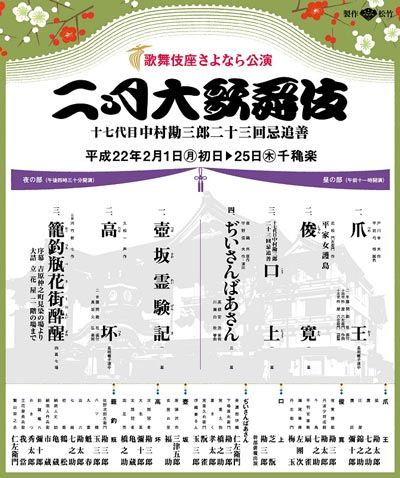| Comments |
14th of the 16 Kabukiza Sayonara K˘en, the Kabukiza Farewell Performances, which will be held up to April 2010.
It commemorates the 22nd anniversary (23rd memorial service) of late Nakamura Kanzabur˘ XVII:
Tsume˘:
(The Talons of the King)
This is a rare performance of a unique dance based on a childrenĺs story of a
falconer and his young falcon by Togawa Yukio (1912~2004). His stories are based on
a wealth of observation of nature and this unlikely theme for a Kabuki dance was first
staged in a commemorative performance for the Saruwaka school of classical Japanese
dance, a school closely associated with the Nakamura Kanzabur˘ family.
Featuring Nakamura Kinnosuke, Band˘ Yajűr˘, Nakamura Shichinosuke and Nakamura Kantar˘.
Shunkan: the priest Shunkan (Nakamura Kanzabur˘) has been exiled to Devil's Island for
plotting against the dictator Kiyomori. A pardon is given to his fellow conspirators, but
Shunkan is only saved by an additional pardon given by Kiyomori's compassionate son. Even so,
he gives up his place on the boat to freedom so his companion's new wife can accompany
her husband back to the capital. The boat leaves and Shunkan is left watching is disappear
in the distance, knowing he will be left on the island forever.
Featuring Ichikawa Sadanji as the evil emissary Senoo and Nakamura Baigyoku as
the merciful envoy Tanzaemon. With Nakamura Shichinosuke as the island girl Chidori and Nakamura Kantar˘ as Naritsune,
Shunkan's fellow exile who has fallen in love with her.
K˘j˘: the close relationship between the actors and the audience
is shown by these stage announcements, lavish ceremonies to commemorate various
important events. In this case, all the stars of the cast assemble to commemorate
the 22nd anniversary (23rd memorial service) of late Nakamura Kanzabur˘ XVII.
Jiisan Baasan: based on a short story by Mori ďgai, this modern play
by Uno Nobuo shows a loving young couple. The samurai Iori travels to Ky˘to with
his lord, leaving Run, his beloved wife, behind. While there, he attacks another
man in a fight over a sword and is forced into house arrest, separating him from
his wife. Many years later, he returns to his home as an old man.
There he meets an elderly woman and they do not recognize each other
until she sees the one thing that has not changed with age,
Iori's peculiar habit of putting his hand to his nose.
Starring Kataoka Nizaemon and Band˘ Tamasabur˘ as Iori and Run. Featuring also Nakamura Kanzabur˘, Nakamura Hashinosuke, Nakamura Senjaku and Kataoka Takatar˘.
Tsubosaka: this play stars Band˘ Mitsugor˘ as Sawaichi, a blind masseur who has
become utterly depressed by the prospect of never recovering his eyesight.
His faithful wife, played by Nakamura Fukusuke, has been praying to the Kannon goddess
daily for several years for his recovery, and Sawaichi agrees to accompany
her to the Kannon shrine to pray. Once there he announces he will stay to
pray and fast for three days, and so his wife leaves to pick up
some supplies for them, but in her absence, Sawaichi throws himself off a cliff.
When she returns, the distraught wife decides to join her husband in death.
The final scene shows the Kannon goddess, who miraculously saves
the couple and cures Sawaichi's blindness.
Takatsuki: in this relatively modern dance-comedy adapted from the style of
classical Ky˘gen farces, the servant Jir˘kaja (Nakamura Kanzabur˘)
is ordered by his lord (Band˘ Yajűr˘) to buy a takatsuki,
which is a kind of ceremonial sake cup on a stand.
Jir˘kaja does not understand his lord's orders and is persuaded by a fast-talking
geta clog salesman (Nakamura Hashinosuke) to buy a pair of clogs instead,
thinking that this is the stand for which he was sent. After drinking a good amount of sake,
he brings his purchase to the lord and responds to the lord's anger with a dance on the clogs,
a virtuoso routine inspired by tap dancing, showing off the dancing skills of Nakamura Kanzabur˘.
Kagotsurube: one of the most sensational plays of late Kabuki,
it shows a humble, pockmarked merchant from the country named Sano Jir˘zaemon (Nakamura Kanzabur˘).
He is wealthy, but because of the way he looks, has never thought that it would be possible to have a woman.
He and his servant go sightseeing in the Yoshiwara pleasure quarters and a
chance look at top courtesan Yatsuhashi (Band˘ Tamasabur˘) who smiles at him, makes
Jir˘zaemon fall in love. However, the pleasure quarters are full of intrigue,
and on the eve of the day that Jir˘zaemon is to buy up Yatsuhashi's contract,
her true love Einoj˘ (Kataoka Nizaemon) forces her to reject and humiliate Jir˘zaemon
in the middle of the celebratory banquet. Jir˘zaemon seems to forgive her,
but returns with the sword Kagotsurube to exact his revenge. Featuring also Kataoka Gat˘ and Kataoka Hidetar˘
in the roles of Tachibanaya Ch˘bŕ and Okitsu.
Source: Earphone Guide website
|


